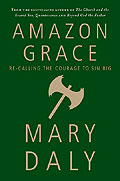 What has happened to the women’s movement and in particular, the Lesbianati™? Has everyone traded principle, freedom, and equality for money and security? Of course, I exaggerate when I say everyone but sometimes it seems that too many women have lost their hunger for justice, too busy to act on their convictions or are disenfranchised, demoralized by a national agenda that often excludes them.
What has happened to the women’s movement and in particular, the Lesbianati™? Has everyone traded principle, freedom, and equality for money and security? Of course, I exaggerate when I say everyone but sometimes it seems that too many women have lost their hunger for justice, too busy to act on their convictions or are disenfranchised, demoralized by a national agenda that often excludes them.
We cannot deny that women and lesbians are underpaid. Domestic violence and rape are epidemic in America and LGBT rights have been derailed by the Religious Right’s assault culturally and politically. The problems women face have improved but marginally at the speed of a snail. Even now, with the presidential candidacy of Sen. Hillary Rodham Clinton, we have witnessed blatant misogyny on display in media and politics.
On CNN, National Council of Women's Organizations founder Martha Burk remarked of Clinton's rival, Sen. Barack Obama, "Were he female, put lipstick and long hair on him, I don't think he would be anywhere near the presidency of the United States right now. . . . Women are perceived differently. They get punished for being competent more than men do, because they're seen as too tough, not gentle, not womanly enough. Conversely, men benefit from gender discrimination." She has a point. Last year, such challenges inspired me to pay homage to a Master painter updated with a modern narrative in a Tribute to Artmesia's Judith.
Last year, such challenges inspired me to pay homage to a Master painter updated with a modern narrative in a Tribute to Artmesia's Judith.
Enduring discrimination, torture, rape, and sexually harassment, Artemisia Gentileschi (1593–1652/1653) achieved fame as a female artist despite the male-dominated post-Renaissance world. She was a pioneer and one of the world’s greatest Masters. Art historian Mary D. Garrard wrote that Artemisia "has suffered a scholarly neglect that is unthinkable for an artist of her calibre." Indeed! But the patriarchy has under-valued the feminine in art, religion, and all aspects of life for thousands of years. Review 20th century artists and the majority of the names are still male. Artemisia might fare better today but I doubt it. Historians have thought that Artemisia painted Judith Slaying Holofernes as a cathartic release from the trauma of being sexually harassed and her virginity raped by Agostino Tassi, her art instructor and family friend. In my tribute to Artemisia, I’ve updated the narrative to reflect today’s human condition and create a metaphorical lightning rod for action. Make no mistake…I am not advocating violence. Protest, yes. Violence, never! I consider the sword in the artwork as a symbol for the divine truth that we are all created equal. And taking action to speak the unvarnished, inspired truth will set us free. One doesn't have to believe in God to embrace such notions; they are fundamental to the U.S. Constitution and mental health.
Historians have thought that Artemisia painted Judith Slaying Holofernes as a cathartic release from the trauma of being sexually harassed and her virginity raped by Agostino Tassi, her art instructor and family friend. In my tribute to Artemisia, I’ve updated the narrative to reflect today’s human condition and create a metaphorical lightning rod for action. Make no mistake…I am not advocating violence. Protest, yes. Violence, never! I consider the sword in the artwork as a symbol for the divine truth that we are all created equal. And taking action to speak the unvarnished, inspired truth will set us free. One doesn't have to believe in God to embrace such notions; they are fundamental to the U.S. Constitution and mental health.
I also modified the Judith figure transforming her into a lesbian, although unless a viewer knows the pink triangle of the pendant hanging around her neck, Judith could be a sister or any woman, a champion for all women. A dark-skinned woman joins her to represent women of color. Together they stand for the female sex, women who have been subverted and disrespected as they allegorically hold down and decapitate America’s patriarchal oppressors.
In the background, a resurrected Christ overshadows a cantilevered bloody-red cross of the male-oriented “suffering” Church to encourage, inspire, and bless the women who are equalizing their situation in life by protesting and thwarting male oppression in whatever form – professionally, religiously, and culturally – to render justice. I daresay, Jesus, who surrounded himself with women and female patrons, calls out, Rise up, Sisters! Come forth, speak the truth, and claim your divine power!
IMAGES: From top to bottom, my 2007 Tribute to Artemisia’s Judith, oil on canvas, 36”w X 48”h; my drawing for the painting, and lastly, Master artist Artemisia Gentileschi's Naples version of Judith Slaying Holofernes, oil on canvas, c. 1612-1613.
Friday, February 22, 2008
Tribute to Artemisia's Judith
Subscribe to:
Comment Feed (RSS)






















